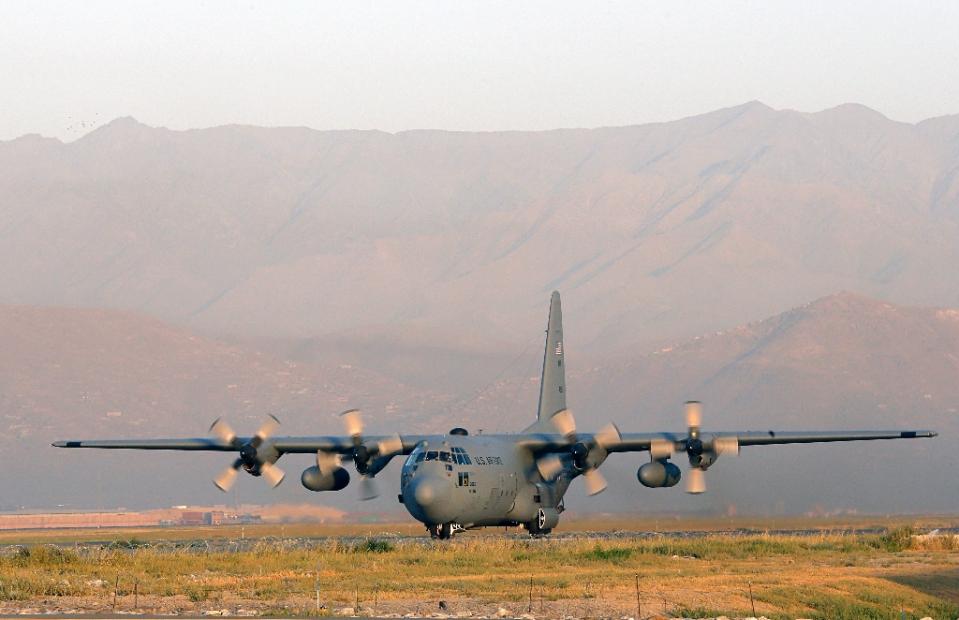Taliban Takes Over Warduj, Claims To Have Shot Down A U.S Plane
Taliban says shot down crashed US C-130 plane in Afghanistan

NEW DELHI: As the battle for Kunduz rages, reports indicate that the Taliban have captured the Warduj district of Badakhshan, east of Kunduz, in northern Afghanistan. In eastern Afghanistan, the Taliban claimed that they had shot down a C-130 military transport plane.
"Our mujahideen have shot down a four-engine US aircraft in Jalalabad," Taliban spokesperson Zabihullah Mujahid said on Twitter. "Based on credible information 15 invading forces and a number of puppet troops were killed."
NATO said that a plane had crashed while taking off from an airport in Afghanistan, and thirteen people including six American service members, were killed. No statement has been released on the cause of the crash, although the US military says there was no hostile activity in the area at the time of the crash -- thereby ruling out the Taliban hand.
Meanwhile, in Kunduz the battle rages, as differing accounts emerge on the success of the Afghan military’s efforts at retaking the city. On Thursday, Afghan officials said that a major operation overnight saw government forces recapturing government landmarks and inflicting heavy casualties on the militants.
"It [Kunduz] is retaken and being cleared from terrorists, with heavy casualties to the enemy," Interior Ministry Spokesman Sediq Sediqqi said on Twitter.
Reports from the ground, however, refer to heavy fighting and the indication that the battle for Kunduz remains undecided. In the government’s account, central parts of Kunduz have been recaptured, but fighting continues in the residential areas as both sides receive reinforcements in the number of fighters.
The capture of Kunduz by the Taliban on Monday night was the militant group’s most decisive victory since the toppling of their government in 2001.
"The fact that the Taliban can actually take the sixth largest city in Afghanistan, and hold it for a couple of days, sends a signal to the government and the international community about the future of Afghanistan," said David Sedney, a former deputy US Assistant Secretary of Defense for Afghanistan and Pakistan, to Al Jazeera, in a statement that indicates why the fall of Kunduz is a major development.
“The Afghan government doesn't even have a defence minister after one year of unity government. This is a government that needs to get down to business and not just talk about having a better security situation,” he said, adding that “Afghan soldiers are great fighters ... They're willing and able to fight but they need a good leadership."
This last fact is especially important as reports indicate that the fall of Kunduz was not the result of a lack of Afghan soldiers, with over 7000 troops present in the city at the time of the Taliban advance, with the Taliban fighters numbering a small 500. “The problem wasn’t lack of security forces,” a district governor who had retreated to the airport, Zalmai Farooqi, told the New York Times, adding that “there was no good leadership to command these men.”
The fall of Kunduz comes just a year after NATO formally ended its mission in Afghanistan, although US led and supported troops continue to remain in the war torn country. It also comes as reports circulate that the US -- which had committed to ending its engagement in Afghanistan -- is reviewing new drawdown options that include keeping thousands of American troops in the country beyond the end of 2016.
The options presented by international commander in Afghanistan, U.S. Army Gen. John Campbell to the Pentagon and NATO for the future of US troop involvement in Afghanistan are: keeping the current U.S. presence at or near 10,000; reducing it slightly to 8,000; cutting the force roughly in half; and continuing with current plans to draw down to a force of several hundred troops by the end of 2016.
With the capture of Kunduz that comes just ahead of Gen. Campbell’s return to the US to testify before Congress on the course of the war and what America’s continued involvement should be, it is likely that the current plan to cut forces to several hundred troops will have the least favour.
Further, the fall of Kunduz should also not come as a major surprise -- as local officials have been sounding the alarm for over a year about the insurgents’ advance into the area. Mohammad Yousuf Ayoubi, the head of the Kunduz provincial council, said that no major government offensive or reinforcement of the city had been taken up recently, even though it was clear the Taliban had been massing at the city’s gates for months, according to The New York Times. “The central government is neglecting Kunduz and its people,” the Times quotes Ayoubi saying. The local officials are incompetent, which is a major reason for the presence of the Taliban.”
The developments in Kunduz are in the context of an upswing in violence in Afghanistan, with a recent UN report noting that the war in Afghanistan is killing or wounding increasing numbers of civilians, with women and children showing the sharpest rise in casualties. Figures for the first six months of 2015 put the year on the path to become the worst year yet in Afghanistan in terms of casualties.
It also comes as a nascent peace dialogue hits a roadblock, following the death of Taliban leader Mullah Omar. As the Taliban confirmed the news, the dialogue process was postponed, with reports indicating that the news had deeply fissured the already heterogenous Taliban. In the weeks that have followed, the side that has opposed talks and negotiations with the government seems to have swelled, with the Taliban stepping up the violence. The fall of Kunduz -- even for just a couple of days -- will further strengthen the factions within the Taliban that want to push through with the insurgency.



